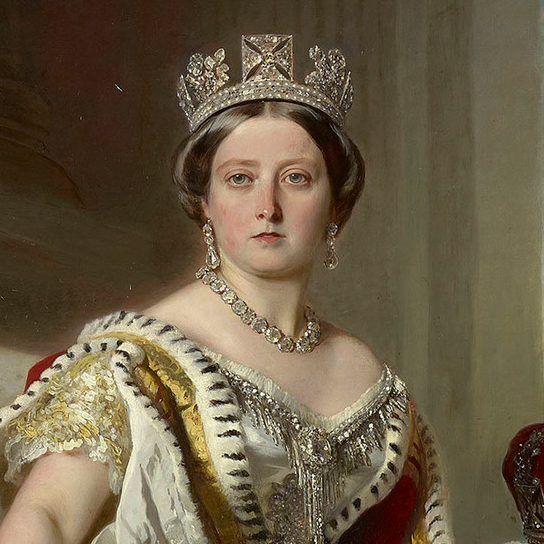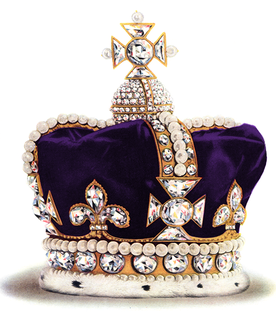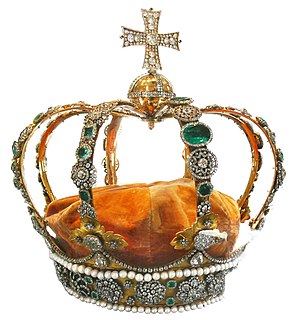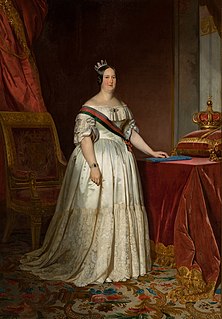
The Necklace of the Stars (Portuguese: Colar das Estrelas) is a diamond necklace originally made for Queen Consort Maria Pia of Savoy. It is a piece of the Portuguese Crown Jewels.

The Necklace of the Stars (Portuguese: Colar das Estrelas) is a diamond necklace originally made for Queen Consort Maria Pia of Savoy. It is a piece of the Portuguese Crown Jewels.
The Necklace of the Stars was made in 1865 for the wife of King Luís I of Portugal, Queen Consort Maria Pia of Savoy, who had a love for jewelry and fashion. The necklace was fashioned in the workshop of the Portuguese Royal Jeweler in Lisbon, Portugal. The necklace is just a piece of a whole set of jewelry that was commissioned by Maria Pia, which includes the famed Diadem of the Stars, the counterpart of the necklace.
It is fashioned out of gold and colourless and pink diamonds.

A tiara is a jeweled, ornamental crown traditionally worn by women. It is worn during formal occasions, particularly if the dress code is white tie.

The Crown Jewels of the United Kingdom, originally the Crown Jewels of England, are a collection of royal ceremonial objects kept in the Tower of London which include the coronation regalia and vestments worn by British monarchs.

Marie-José of Belgium was the last Queen of Italy. Her 34-day tenure as queen consort earned her the nickname "the May Queen".

The French Crown Jewels comprise the crowns, orb, sceptres, diadems and jewels that were symbols of Royal power between 752 and 1825. These were worn by many Kings and Queens of France. The set was finally broken up, with most of it sold off in 1885 by the Third Republic. The surviving French Crown Jewels, principally a set of historic crowns, diadems and parures, are mainly on display in the Galerie d'Apollon of the Louvre, France's premier museum and former royal palace, together with the Regent Diamond, the Sancy Diamond and the 105-carat (21.0 g) Côte-de-Bretagne red spinel, carved into the form of a dragon. In addition, some gemstones and jewels are on display in the Treasury vault of the Mineralogy gallery in the National Museum of Natural History.

The George IV State Diadem, officially the Diamond Diadem, is a crown that was made in 1820 for King George IV. The diadem is worn by queens and queens consort in procession to coronations and State Openings of Parliament. It has been featured in paintings and on stamps and currency.
A consort crown is a crown worn by the consort of a monarch for their coronation or on state occasions.

The State Crown of Mary of Modena is the consort crown made in 1685 for Mary of Modena, queen of England, Scotland and Ireland. It was used by future queens consort up until the end of the 18th century.

The Small Diamond Crown of Queen Victoria is a miniature imperial and state crown made at the request of Queen Victoria in 1870 to wear over her widow's cap following the death of her husband, Prince Albert. It was perhaps the crown most associated with the queen and is one of the Crown Jewels on public display in the Jewel House at the Tower of London.

Dona Maria Pia was by birth an Italian princess of the of the House of Savoy and was Queen of Portugal as spouse of King Luís I of Portugal. On the day of her baptism, Pope Pius IX, her godfather, gave her a Golden Rose. Maria Pia was married to Luís on the 6 October 1862 in Lisbon. She was the grand mistress of the Order of Saint Isabel. She was the third queen of the House of Savoy on the Portuguese throne, after Mafalda and Marie-Françoise of Savoy-Nemours.

The Spanish Royal Crown may refer to either the heraldic crown, which does not exist physically, or the crown known as the corona tumular, a physical crown used during Spanish royal proclamation ceremonies since the 18th century.

The monarch of the Commonwealth realms, Queen Elizabeth II, owns a historic collection of jewels – some as monarch and others as a private individual. They are separate from the Gems and Jewels and the coronation and state regalia that make up the Crown Jewels.

The Crown Jewels of Württemberg are a historical jewel collection belonging to the Kings and Queens of Württemberg.

The Pantheon of the House of Braganza, also known as the Pantheon of the Braganzas, is the final resting place for many of the members of the House of Braganza, located in the Monastery of São Vicente de Fora in the Alfama district of Lisbon, Portugal. The pantheon's burials have included Portuguese monarchs, Brazilian monarchs, a Romanian monarch, queen consorts of Portugal, and notable Infantes of Portugal, among others.

The Portuguese Crown Jewels, also known as the Royal Treasure, are the pieces of jewelry, regalia, and vestments that were used by the Kings and Queens of Portugal during the time of the Portuguese Monarchy. Over the nine centuries of Portuguese history, the Portuguese Crown Jewels have lost and gained many pieces. Most of the current set of the Portuguese Crown Jewels are from the reigns of King João VI and King Luís I.

The Diadem of the Stars is a Diamond Tiara originally commissioned by Queen Consort Maria Pia of Savoy, who had a love for jewelry and fashion. It is a piece of the Portuguese Crown Jewels.

Crown Jewels of the Netherlands is the jewellery used by the Dutch royal family, which is sometimes dubbed "crown jewels". In the past, the terms "House-diamonds", "House-jewels" and "family jewels" have been used. In 1790 the term "Bijoux de la Couronne" was used by Luise of Brunswick -Wolfenbüttel to refer to a large diamond from Borneo. In 1896 the Firm of van Kempen & Begeer wrote about resetting the jewels of the Crown. Queen Juliana gave a selection of her formal jewelry to the new Foundation Regalia of the House of Orange-Nassau, instituted on 27 July 1963. In 1968 a Foundation "Kroongoederen van het Huis van Oranje-Nassau" was instituted. It owns the regalia and the House-jewels.

Diana, Princess of Wales, the first wife of Charles, Prince of Wales, and mother of Prince William and Prince Harry, owned a collection of jewels, both as a member of the British royal family and as a private individual. These were separate from the coronation and state regalia of the Crown Jewels. Most of her jewels were either presents from foreign royalty, on loan from Elizabeth II, wedding presents, purchased by Diana herself, or heirlooms belonging to the Spencer family.

The Three Brothers was a piece of jewellery created in the late 14th century, which consisted of three rectangular red spinels arranged around a central diamond. The jewel is known for having been owned by a number of important historical figures. After its commission by Duke John the Fearless of Burgundy, the jewel was part of the Burgundian crown jewels for almost 100 years, before passing into the possession of German banker Jakob Fugger.

Jewelry of the Swedish Royal Family is the set of ceremonial jewels been owned by members of the Swedish royal family or by the Bernadotte family foundations. The Swedish national regalia, which have a symbolic meaning and are not to be regarded as jewelry, are, on the other hand, owned by the Swedish state.

The Tiara of Maria II is a jewelled, ornamental crown made for Queen Maria II of Portugal in the 1830s-40s, set in sapphires and diamonds. It is the oldest extant tiara that can be linked to a Portuguese sovereign.